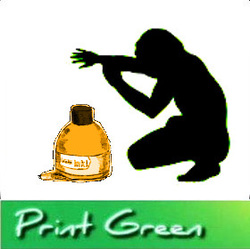
From the technology used in wine press, Johannes Gutenberg derived his own idea and created his own printing press based on the technologies he had at that time. He was able to build a printing machine out of wood materials, a machine that feeds in paper and slides it out after printing. It became popular all around the world and was widely used by many professionals, and eventually it was divided into two types mainly the inkjet and laserjet printers.
A printing system called "moveable-type" which originated from China, was perhaps the second development stage of the printing press. It looks really huge compared to its modern version in the late 60's, the electromechanical writing machine or commonly known as the typewriter. Before, the printing press used metal pieces with embossed letter carvings stamped with inks, these are then pressed onto the paper sheet creating the printout.
Now have you wondered what kind of ink was used back then for printing books and readable materials? Long before the genius Gutenberg invented his marvelous printing press machine, ink was already used for printing purposes. Traditionally, people used water-based inks for block printing, however when Gutenberg tried it in his machine, the water-based ink run off the letters. The paper material they were using before was actually damped, this is to allow the ink to withhold effectively onto the paper. So Gutenberg came up with another idea, a thicker ink should be made, which led to the birth of oil-based ink.
Gutenberg was successful on developing the oil-based ink, his mixture includes lead, copper, sulfur and titanium, hence the printout glitters at some time. Nowadays, ink materials are produced in mass volumes especially by most printer manufacturers for they need to manufacture ink cartridges for their machines and electronic products. Improvement goes along the way, which results to ink mixtures that contained less metal elements.
Aside from the typical ink cartridges that the market offers, there we also have soy-based or bio-based inks, as well as those eco-friendly toner cartridges and ink cartridges which are more efficient to the environment. It took years of research and development until finally, the printing press spread out all around the world and was widely used by most publishing companies. Authors and newspaper publishing companies greatly benefited from it, and they should be thankful solely to the printing press inventor by the name Johannes Gutenberg.
A printing system called "moveable-type" which originated from China, was perhaps the second development stage of the printing press. It looks really huge compared to its modern version in the late 60's, the electromechanical writing machine or commonly known as the typewriter. Before, the printing press used metal pieces with embossed letter carvings stamped with inks, these are then pressed onto the paper sheet creating the printout.
Now have you wondered what kind of ink was used back then for printing books and readable materials? Long before the genius Gutenberg invented his marvelous printing press machine, ink was already used for printing purposes. Traditionally, people used water-based inks for block printing, however when Gutenberg tried it in his machine, the water-based ink run off the letters. The paper material they were using before was actually damped, this is to allow the ink to withhold effectively onto the paper. So Gutenberg came up with another idea, a thicker ink should be made, which led to the birth of oil-based ink.
Gutenberg was successful on developing the oil-based ink, his mixture includes lead, copper, sulfur and titanium, hence the printout glitters at some time. Nowadays, ink materials are produced in mass volumes especially by most printer manufacturers for they need to manufacture ink cartridges for their machines and electronic products. Improvement goes along the way, which results to ink mixtures that contained less metal elements.
Aside from the typical ink cartridges that the market offers, there we also have soy-based or bio-based inks, as well as those eco-friendly toner cartridges and ink cartridges which are more efficient to the environment. It took years of research and development until finally, the printing press spread out all around the world and was widely used by most publishing companies. Authors and newspaper publishing companies greatly benefited from it, and they should be thankful solely to the printing press inventor by the name Johannes Gutenberg.
 RSS Feed
RSS Feed